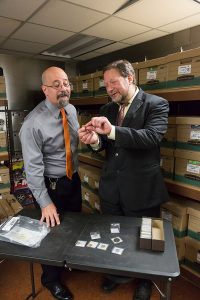Pull a coin from your pocket. How many times did that coin change hands until it found its way on to your open palm? How many goods has it purchased, and whose hands has it touched? I often ponder these questions, so when we received a message from the Virginia Treasury Department’s Division of Unclaimed Property regarding a small box of abandoned ancient Byzantine coins, I was immediately intrigued.
The coins, we learned, had been found on a bench in a vault in a Northern Virginia bank and turned over to the Virginia Treasury Department in downtown Richmond. Curious about the coins’ value and condition, the division’s supervisor solicited the expertise of Dr. Peter Schertz, VMFA’s Jack and Mary Ann Frable Curator of Ancient Art, for whom I work as intern.
 Admittedly, neither Peter nor I had particularly high expectations as we drove to the Treasury Department’s office, but our sentiments quickly changed upon viewing the coins. They were absolutely stunning—meticulously labeled, carefully packaged, and clearly well loved. But how did they end up forgotten on a lowly vault bench? What began as a quasi-appraisal project soon morphed into a full investigation in hopes of returning the coins to their legal owner.
Admittedly, neither Peter nor I had particularly high expectations as we drove to the Treasury Department’s office, but our sentiments quickly changed upon viewing the coins. They were absolutely stunning—meticulously labeled, carefully packaged, and clearly well loved. But how did they end up forgotten on a lowly vault bench? What began as a quasi-appraisal project soon morphed into a full investigation in hopes of returning the coins to their legal owner.
Rather than imagining how and when these coins might have changed hands, we conducted research so as to map their actual path of exchange, challenging me to put casual interests into practice. Each coin was accompanied by a detailed label that included its physical description, metal type, and place of origin. Some labels also contained information about auction houses, dates, and lot numbers, while several others cited names of specific dealers or numismatists. Peter personally knew some of the people listed, while I researched those he did not. I searched the auction houses online, poring through their digital records to find as much information about the coins as I could, hoping they might point us toward an owner, the missing link in their contemporary family tree of sorts.
For the sake of brevity I will keep the process, which itself was quite speedy, short: using the information we gleaned from Peter’s personal contacts and my research, we contacted dealers, who searched their records. Not more than a few days after our initial meeting at the Virginia Treasury Department, we found their owner. Weeks later, we were back at the Treasury building, placing the coins into the hands of their eager, and rightful, owner.
Most of us understand that it is the role of the museum to ensure the physical integrity of its collections while making them widely available to the public as part of its educational mission. What made this experience particularly special, though, was having the opportunity to partner with another state institution to locate the current owner of the coins. And while this post is not an argument for or against the ethics of repatriation, the Byzantine coins do illustrate the importance of honesty, collaboration and documenting provenance.